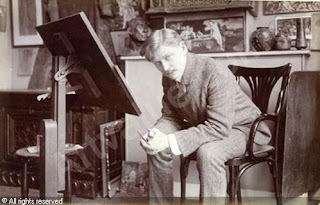Wednesday, July 15th., Salzburg.
Saturday night we went to the Stadt Theatre, and saw a Viennese
'schnurre', a farce of military life. Couldn't understand it, but it seemed to be pretty well put together. The production was far far better than our average West End production. It was more naturalistic, less conventional, and more continuously alive. Some of the acting was very good.
The scenery around is wonderful. There must be about a dozen 10,000 ft. mountains in the region. But we soon tired of this imposing, picturesque scenery. It is as if it was done on purpose - some
tour de force of a creator. Sunday was a fete day here - the fete of the fire brigades. They came from all around including adjacent Germany. The cafe-restaurants were full of firemen, in poor ill-fitting uniforms, at lunch. Procession very long. Full of engines and ladders, and one very old engine, and banners and bands. One brigade was headed by a girl in white; at least she seemed to be a girl; but she might have been the wife of the huge, framed, glittering man who was walking by her side. The affair had a certain medieval or renaissance quality, but lacked both vitality and efficiency. After it we drove in a little victoria to see the castle (Lustschloss) at Hellbrun, a few miles off, along a monotonous road, chiefly quite straight. This castle has lovely gardens; but the 'practical joke' quality of the fountain-work (designed to soak the king's guests by surprise) and the childishness of the working, water-driven models in the garden, gave you a sinister insight into the mind of a foolish king.

In 1612, only a few months after ascending the throne, Salzburg's Prince Archbishop Markus Sittikus von Hohenems commissioned a country residence to be built at the foot of the well-watered Hellbrunn Mountain. A lover of Italian art and culture, Markus Sittikus commissioned the famous Cathedral architect, Santino Solari, to design a "villa suburbana", a summer residence matching the elegance and spaciousness of the magnificent Italian architecture with which he was so obsessed. Within a relatively short period of time an architectural masterpiece was created just south of the city that remains one of the most magnificent Renaissance buildings north of the Alps: the Lustschloss ("pleasure palace") of Hellbrunn with its spacious park and its unique Wasserspiele (trick fountains). Water was the central theme in the palace's design. The numerous sources in Hellbrunn Mountain gave the estate effervescent life. Hidden in the shade of bushes and trees or jetting out from unexpected hiding places - the world-famous Wasserspiele have been the main attraction at Hellbrunn for almost 400 years.
Much work in mornings. I am reading Hamsun's "Segelfoss Town". It is not his best work but contains some very fine things indeed, and is never sentimental. I read some of Robert Bridges's poems again, including the one containing the line "The horses of the strong south west", which has remained in my mind for many years. It is a superb short poem.
Who has not walked upon the shore,
And who does not the morning know,
The day the angry gale is o'er,
The hour the wind has ceased to blow?
The horses of the strong south-west
Are pastured round his tropic tent,
Careless how long the ocean's breast
Sob on and sigh for passion spent.
The frightened birds, that fled inland
To house in rock and tower and tree,
Are gathering on the peaceful strand,
To tempt again the sunny sea ;
Whereon the timid ships steal out
And laugh to find their foe asleep,
That lately scattered them about,
And drave them to the fold like sheep.
The snow-white clouds he northward chased
Break into phalanx, line, and band:
All one way to the south they haste,
The south, their pleasant fatherland.
From distant hills their shadows creep,
Arrive in turn and mount the lea,
And flit across the downs, and leap
Sheer off the cliff upon the sea ;
And sail and sail far out of sight.
But still I watch their fleecy trains,
That piling all the south with light,
Dapple in France the fertile plains.
Yesterday was what I call a full day, after a rotten night. I didn't get up till 8 o'clock; then breakfast; by 11.15 I had written 950 words of the novel. I then dressed and went out to recover, to reflect, and to find a new restaurant. We lunched at the new restaurant. Back to hotel to sleep, read and tea. Then by the giant lift to the Cafe-Wein Restaurant on the Monchberg; walked on the said berg for a long time (acutely picturesque). Then descended by the lift and to St. Peter's Keller for dinner; place crowded. Then to hotel for tickets for theatre, and to "The Blue Bird" (Russian troupe as in London) at Stadt Theatre. Some of it very good; a little of it magnificent.
The Mönchsberg, at 540 meters (1,770 ft) above sea level, is one of the five mountains in the city of
Salzburg,
Salzburgerland,
Austria. It is named after the
Benedictine monks of
St Peter's Abbey at the northern foot of the mountain. The Mönchsberg plateau offers a small-scale change of forests and meadows and therefore is a popular local recreation area for the Salzburg citizens and tourists.






























